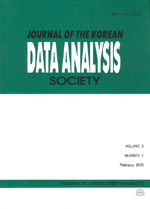혼합물 실험에서 모형설정에 관한 연구
A Study on Modeling in Mixture Experiments
- 한국자료분석학회
- Journal of The Korean Data Analysis Society (JKDAS)
- Vol.17 No.2
-
2015.04759 - 766 (8 pages)
- 14

혼합물 실험에서는 반응변수가 혼합물의 성분인 설명변수들의 절대량이 아닌 상대적인 혼합비율에 의해 영향을 받는다. 이러한 반응변수와 혼합물 성분들의 특이한 관계를 나타내기 위하여 Scheffe의 다항모형이나 관련 모형들이 제시되어 있다. 적절한 모형설정을 하기 위해서 통상적인 단계별 변수선택법을 적용할 때 혼합물 성분들의 공선성 때문에 문제가 발생할 수 있어, 모든 가능한 회귀법을 사용하여 몇 가지 변수선택 기준을 적용하여 최적모형을 설정하는 방법이 추천되기도 한다. 본 논문에서는 혼합물 성분들의 공선성에 대하여 로버스트한 모형설정 방법으로 Taguchi, Rajesh(2000)에 소개된 Mahalanobis 거리를 이용하는 마할라노비스 다구찌 시스템(Mahalanobis Taguchi system) 절차를 활용하여 변수선택을 하고 부분모형을 결정하는 절차를 제시한다. 사례분석으로 Cornell(2002)에 소개된 종이 코팅제의 표면저항성 자료를 사용하여, Scheffe의 다항모형에 역수항들을 추가한 모형으로부터 변수들을 선택하고 부분모형을 설정하는 방법을 적용하고 결과를 설명한다.
In mixture experiments, the measured response is assumed to depend only on the proportions of the components present in the mixture, not on the amounts of the components. To model this special mixture system properly, Scheffe polynomials and some alternative modeling forms, including models with inverse terms, are used. For obtaining the best model in mixture experiments, commonly used variable selection techniques are the stepwise type methods. However, the model obtained from using these methods is not always the best model depending on the chosen criteria, since the model obtained this way can be affected by collinearity. In this paper, we consider a model selection strategy robust to collinearity using the Mahalanobis Taguchi system (MTS) to model a mixture system. This strategy is illustrated through an example where the Scheffe type mixture models with additional inverse terms are used for modeling of the mixture with three components in the paper coating experiment studied in Cornell (2002)
1. 서론
2. 모형설정
3. 적용사례
4. 결론
References
(0)
(0)